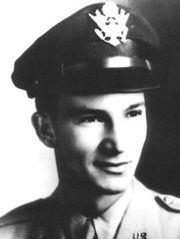Years of service 1942–1944 Education Virginia Tech Name Robert Femoyer | Rank Second Lieutenant Battles and wars World War II | |
 | ||
Born October 31, 1921Huntington, West Virginia ( 1921-10-31 ) Service/branch | ||
Robert Edward Femoyer (October 31, 1921 – November 2, 1944) is one of only nine known Eagle Scouts to receive the Medal of Honor; the others are Aquilla J. Dyess, Eugene B. Fluckey, Thomas R. Norris, Arlo L. Olson, Mitchell Paige, Ben L. Salomon, Leo K. Thorsness, and Jay Zeamer, Jr.. He served in the U.S. Army Air Forces and is the only navigator awarded the Medal of Honor.
Contents
Biography
Femoyer was from Huntington, West Virginia, an Eagle Scout, he attended Virginia Tech, from 1940 to 1943. A building at Virginia Tech is named in his honor.
Femoyer joined the Enlisted Reserve Corps on November 11, 1942 and was called to active duty in February 1943. He took basic training at Miami Beach, Florida, aircrew training at the University of Pittsburgh, and became an aviation cadet at the Mississippi Institute of Aeronautics in Jackson but failed his pilot training. In 1944, he graduated from the Army Air Force (AAF) Flexible Gunnery School at Fort Myers, Florida, and the AAF Navigation School at Selman Field, Louisiana. From his training assignments, he went to the European Theater in September 1944, as a second lieutenant and was assigned to the 447th Bomb Group's 711th Bombardment Squadron.
Six weeks later, on November 2, 1944, he was the navigator of a B-17 Flying Fortress on a bombing mission over Merseburg, Germany, his bomber was struck by three antiaircraft shells and he was wounded. He was in pain and had significant blood loss, but refused morphine in order to keep his head clear while he continued to navigate the bomber for two and a half hours, changing course six times to avoid enemy antiaircraft fire. He remained alert though his pain was described as "almost beyond the realm of human endurance". Once the airplane was in safe airspace over the English Channel, Femoyer finally agreed to an injection of morphine; but thirty minutes after landing he died of wounds. His actions saved the lives of the entire crew. For his actions during this mission, he posthumously received the Medal of Honor. His body rests in Jacksonville, Florida.
Military awards and other honors
Second Lieutenant Femoyer's awards include the Medal of Honor and the Purple Heart
Medal of Honor citation
General Orders: War Department, General Orders No. 35, May 9, 1945
"The President of the United States in the name of The Congress takes pleasure in presenting the Medal of Honor (Posthumously) to
UNITED STATES ARMY AIR FORCES
for service as set forth in the following CITATION:
For conspicuous gallantry and intrepidity at the risk of his life above and beyond the call of duty near Merseburg, Germany, on 2 November 1944. While on a mission, the bomber, of which 2d Lt. Femoyer was the navigator, was struck by 3 enemy antiaircraft shells. The plane suffered serious damage and 2d Lt. Femoyer was severely wounded in the side and back by shell fragments which penetrated his body. In spite of extreme pain and great loss of blood he refused an offered injection of morphine. He was determined to keep his mental faculties clear in order that he might direct his plane out of danger and so save his comrades. Not being able to arise from the floor, he asked to be propped up in order to enable him to see his charts and instruments. He successfully directed the navigation of his lone bomber for 2 1/2 hours so well it avoided enemy flak and returned to the field without further damage. Only when the plane had arrived in the safe area over the English Channel did he feel that he had accomplished his objective; then, and only then, he permitted an injection of a sedative. He died shortly after being removed from the plane. The heroism and self-sacrifice of 2d Lt. Femoyer are in keeping with the highest traditions of the U.S. Army.
/S/ HARRY S. TRUMAN"
Femoyer Hall
Virginia Tech's Femoyer Hall is named for Second Lieutenant Femoyer, a member of the Class of 1944. Femoyer Hall was originally built as a residence hall in 1949, and is currently an academic building serving as the home to the Naval ROTC unit at Virginia Tech as well as houses the Student Success Center.
